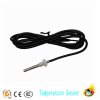Hi all,
I am using a PT1000 temperature sensor for a project. This sensor has 1000 ohms with zero °C. Now i want to connect this temperature sensor to a voltage comparator and therefore need a voltage output and not resistance. To do so i used a voltage divider.
Now my problem is that the output voltage is varying slightly (few milli volts from room temperature to 100°C). How can i increase the gap of the output voltage (for instance 10mV per 1°C) ??
Note that i can only use the PT1000 sensor.
Any help is appreciated.
Thanks is advance
I am using a PT1000 temperature sensor for a project. This sensor has 1000 ohms with zero °C. Now i want to connect this temperature sensor to a voltage comparator and therefore need a voltage output and not resistance. To do so i used a voltage divider.
Now my problem is that the output voltage is varying slightly (few milli volts from room temperature to 100°C). How can i increase the gap of the output voltage (for instance 10mV per 1°C) ??
Note that i can only use the PT1000 sensor.
Any help is appreciated.
Thanks is advance




